
Iza is a town and municipality in Boyacá Department, Colombia. Iza is located near the Tota Lake and part of the Sugamuxi Province, a subregion of Boyacá. Iza is located in the Eastern Ranges of the Colombian Andes on the Altiplano Cundiboyacense at a distance of 13 kilometres (8.1 mi) from Sogamoso and 90 kilometres (56 mi) from the department capital Tunja. The municipality borders Firavitoba and Sogamoso in the north, Sogamoso and Cuítiva in the east, in the west Pesca and Firavitoba, and in the south Cuítiva.
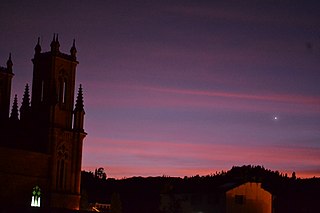
Firavitoba is a town and municipality in Sugamuxi Province, a subregion of the department of Boyacá in Colombia.
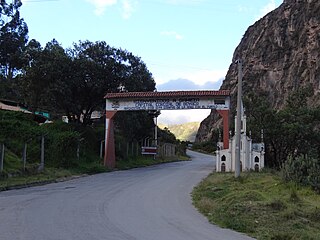
Gámeza is a town and municipality in the Colombian Department of Boyacá, part of the Sugamuxi Province, a subregion of Boyacá. The town center is located at 18 kilometres (11 mi) from Sogamoso and the municipality borders Tasco and Corrales in the north, Tópaga and Mongua in the south, in the east Socotá and westward of Gámeza Corrales and Tópaga.

Pesca is a town and municipality in the Colombian Department of Boyacá, part of the Sugamuxi Province, a subregion of Boyacá. The town is located in the Eastern Ranges of the Colombian Andes at altitudes between 2,540 metres (8,330 ft) and 4,000 metres (13,000 ft). Pesca is 108 kilometres (67 mi) west from the department capital Tunja and borders Firavitoba in the north, Iza in the northeast, Tuta in the northwest, in the east Tota, Zetaquirá in the south, Rondón and Siachoque in the southwest and Toca in the west.
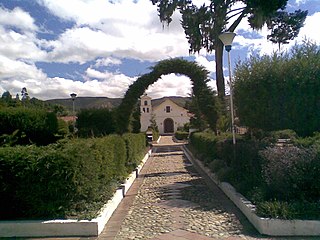
Busbanzá is a town and municipality in the Colombian Department of Boyacá. Busbanzá is part of the Tundama Province, a subregion of Boyacá. Busbanzá is located at 25 kilometres (16 mi) from Sogamoso. It borders Betéitiva in the north, in the east and south Corrales and in the west Floresta.

Bochica is a figure in the religion of the Muisca, who inhabited the Altiplano Cundiboyacense during the arrival of the Spanish conquistadors in the central Andean highlands of present-day Colombia. He was the founding hero of their civilization, who according to legend brought morals and laws to the people and taught them agriculture and other crafts, including textiles.

Knowledge of Muisca mythology has come from Muisca scholars Javier Ocampo López, Pedro Simón, Lucas Fernández de Piedrahita, Juan de Castellanos and conquistador Gonzalo Jiménez de Quesada who was the European making first contact with the Muisca in the 1530s.

The Muisca Confederation was a loose confederation of different Muisca rulers in the central Andean highlands of what is today Colombia before the Spanish conquest of northern South America. The area, presently called Altiplano Cundiboyacense, comprised the current departments of Boyacá, Cundinamarca and minor parts of Santander.
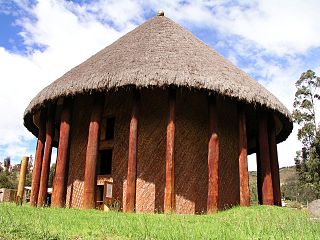
Idacansás, Idacansas, Idacanzas or Iduakanzas was a mythical cacique who was said to have been the first priest of the sacred city of Sugamuxi, present-day Sogamoso, Colombia, then part of the territories of the Muisca. He is characterized by his great magical powers as he could make rain and hail and transmit diseases and warmth.

Chiminigagua, Chiminichagua or Chimichagua was the supreme being, omnipotent god and creator of the world in the religion of the Muisca. The Muisca and their confederation were one of the four advanced civilizations of the Americas and developed their own religion on the Altiplano Cundiboyacense in the Andes.

Sué, Xué, Sua, Zuhe or Suhé was the god of the Sun in the religion of the Muisca. He was married to Moon goddess Chía. The Muisca and their confederation were one of the four advanced civilizations of the Americas and developed their own religion on the Altiplano Cundiboyacense in the Andes. Both the Sun and rain, impersonated by Chibchacum, were very important for their agriculture.

The Sun Temple of Sogamoso was a temple constructed by the Muisca as a place of worship for their Sun god Sué. The temple was built in Sogamoso, Colombia, then part of the Muisca Confederation and called Sugamuxi. It was the most important temple in the religion of the Muisca. The temple was destroyed by fire brought by the Spanish conquistadores led by Gonzalo Jiménez de Quesada who was eager to find the legendary El Dorado. A reconstruction has been built in the Archeology Museum of Sogamoso.
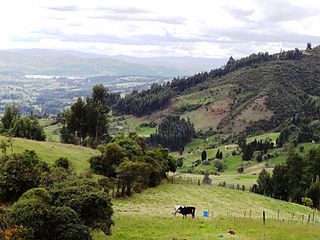
Tundama or Saymoso was a cacique of the Muisca Confederation, a loose confederation of different rulers of the Muisca who inhabited the central highlands of the Colombian Andes. The city of Tundama, currently known as Duitama and part of the Tundama Province, Boyacá, were named after the cacique. Tundama ruled over the northernmost territories of the Muisca, submitted last by the Spanish conquistadores.
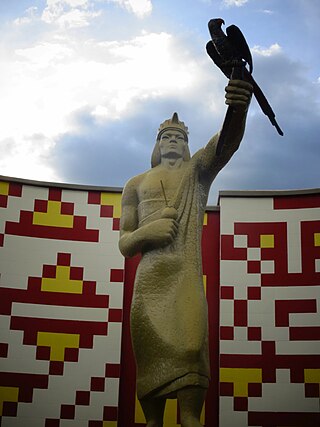
Sugamuxi was the last iraca; cacique of the sacred City of the Sun Suamox. Sugamuxi, presently called Sogamoso, was an important city in the religion of the Muisca who inhabited the Altiplano Cundiboyacense in the times before the Spanish conquistadors reached the central highlands of the Colombian Andes. Fellow Muisca rulers of other territories within the Muisca Confederation were Tundama in Tundama, zaque Aquiminzaque in Hunza and zipa Sagipa in Bacatá.
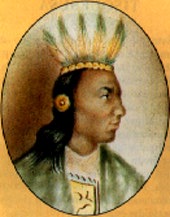
The Hunzahúa Well is an archeological site of the Muisca located in the city of Tunja, Boyacá, which in the time of the Muisca Confederation was called Hunza. The well is named after the first zaque of Hunza, Hunzahúa. The well was called Pozo de Donato for a while, after 17th century Jerónimo Donato de Rojas. The well is located on the campus of the Pedagogical and Technological University of Colombia in Tunja. Scholar Javier Ocampo López has written about the well and its mythology. Knowledge about the well has been provided by scholar Pedro Simón.

Nompanim or Nomparem was the penultimate iraca; cacique of the sacred City of the Sun; Sugamuxi. Sugamuxi, presently called Sogamoso, was an important city in the religion of the Muisca who inhabited the Altiplano Cundiboyacense in the times before the Spanish conquest of the Muisca conquistadores reached the central highlands of the Colombian Andes. Fellow Muisca rulers of other territories within the Muisca Confederation were Tundama in Tundama, zaque Quemuenchatocha in Hunza and zipas Nemequene and Tisquesusa in Bacatá.

This article describes the astronomy of the Muisca. The Muisca, one of the four advanced civilisations in the Americas before the Spanish conquest of the Muisca, had a thorough understanding of astronomy, as evidenced by their architecture and calendar, important in their agriculture.

This article describes the economy of the Muisca. The Muisca were the original inhabitants of the Altiplano Cundiboyacense, the high plateau in the Eastern Ranges of central present-day Colombia. Their rich economy and advanced merchant abilities were widely known by the indigenous groups of the area and described by the Spanish conquistadores whose primary objective was the acquisition of the mineral resources of Tierra Firme; gold, emeralds, carbon, silver and copper.

The Goranchacha Temple is an archeological site of the Muisca located in the city of Tunja, Boyacá, which in the time of the Muisca Confederation was called Hunza. The temple is named after the mythological Goranchacha. The remains of the temple are located on the terrain of the Pedagogical and Technological University of Colombia in Tunja. Scholar Javier Ocampo López has written about the temple and its religious meaning. Knowledge about the temple has been provided by chronicler Pedro Simón.
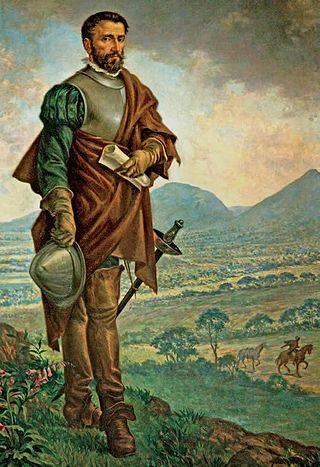
The Spanish conquest of the Muisca took place from 1537 to 1540. The Muisca were the inhabitants of the central Andean highlands of Colombia before the arrival of the Spanish conquistadors. They were organised in a loose confederation of different rulers; the psihipqua of Muyquytá, with his headquarters in Funza, the hoa of Hunza, the iraca of the sacred City of the Sun Sugamuxi, the Tundama of Tundama, and several other independent caciques. The most important rulers at the time of the conquest were psihipqua Tisquesusa, hoa Eucaneme, iraca Sugamuxi and Tundama in the northernmost portion of their territories. The Muisca were organised in small communities of circular enclosures, with a central square where the bohío of the cacique was located. They were called "Salt People" because of their extraction of salt in various locations throughout their territories, mainly in Zipaquirá, Nemocón, and Tausa. For the main part self-sufficient in their well-organised economy, the Muisca traded with the European conquistadors valuable products as gold, tumbaga, and emeralds with their neighbouring indigenous groups. In the Tenza Valley, to the east of the Altiplano Cundiboyacense where the majority of the Muisca lived, they extracted emeralds in Chivor and Somondoco. The economy of the Muisca was rooted in their agriculture with main products maize, yuca, potatoes, and various other cultivations elaborated on elevated fields. Agriculture had started around 3000 BCE on the Altiplano, following the preceramic Herrera Period and a long epoch of hunter-gatherers since the late Pleistocene. The earliest archaeological evidence of inhabitation in Colombia, and one of the oldest in South America, has been found in El Abra, dating to around 12,500 years BP.


















